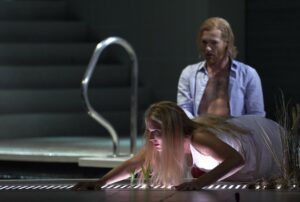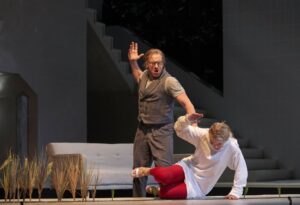Magic was present in the theatre on the banks of the Wien River from the very beginning. Emanuel Schikaneder’s troupe moved to a new building on the other bank of the river – almost exactly opposite the Freihaustheater – ten years after the premiere of The Magic Flute. The opening of the Empire-style building, erected in 1801 after a design by Franz Jäger, was celebrated with an allegory Thespis Traum by Schikaneder and Franz Teyber’s heroic opera Alexander. Schikaneder’s dream theatre boasted the biggest and best equipped stage in the entire Habsburg realm. The high-spending impresario spared no expense, putting his wild ideas into practice, as a result of which he had to get rid of the Theater an der Wien less than three years later. However, he did retain the position of its artistic director for a while. The premiere of Leonora, the original version of Beethoven’s Fidelio, took place in 1805, when Schikaneder was already in deep financial trouble. He died impoverished and lonely seven years later. The theatre changed hands many times, with successive owners carrying out alterations and presenting all kinds of works – from operas and operettas, through ballets and pantomimes, to plays. Yet Schikaneder’s mad ghost hovered over the building for decades, watching over the premiere of Schiller’s The Maid of Orleans – featuring eighty horses and four hundred human performers – and the golden age of Viennese operetta marked by the triumphs of Johann Strauss’ Die Fledermaus and The Gypsy Baron. After WWII the Theater an der Wien served for a while as a venue for performances of the damaged Staatsoper; in the 1960s – having miraculously avoided a conversion into a municipal car park – it switched to musicals, occasionally making its stage available for Wiener Festwochen events. In 2006, after an extensive renovation, it reopened its doors as an opera house.
Today this historicising-modernist jewel, hidden in the Linke Wienzeile frontage almost as effectively as the Wien River hidden under the Naschmarkt, presents nearly thirty works per season – this season its repertoire includes thirteen new productions and two world premieres (Egmont by Christian Jost and Genia by Tscho Theissing). In December the Viennese theatre will present Halka directed by Mariusz Treliński and featuring the Arnold Schoenberg Chor and ORF Radio-Symphonieorchester Wien conducted by Łukasz Borowicz. I glanced at the cast of Rusalka, opening the new season, and decided to visit Vienna already in September – to see the interior, hear the acoustics and enjoy a potentially excellent performance of one of my beloved operas. And, if fate would have it, to feast my eyes and ears on an inspired staging of Dvořák’s masterpiece.
Maria Bengtsson (Rusalka) and Ladislav Elgr (Prince). Photo: Herwig Prammer
Fate wouldn’t have it. The German Amélie Niermeyer took on opera directing in 2007, at the Deutsche Oper am Rhein in Düsseldorf, where she staged Wozzeck, La clemenza di Tito and Rigoletto, among others. Since then she has shown many times that she likes to ride roughshod over the queen of musical forms, picking out individual threads and twisting them to fit her own, often one-dimensional concept. In her recent staging of Otello at the Bayerische Staatsoper she managed to reduce the opera to an analysis of marital problems between Desdemona and the eponymous hero, leaving aside the rest of the complicated narrative, which, incidentally, in Verdi and Boito’s version differs substantially from the Shakespeare’s original. When working on Otello, Niermeyer was accompanied by the set designer Christian Schmidt, a regular theatrical partner of Claus Guth. She invited Schmidt to Vienna as well, relying completely on the German artist’s talent – like many other contemporary directors guided by a wholly mistaken premise that what the audiences look for at the opera are, above all, visual thrills.
Unfortunately, Schmidt limited himself to shamelessly recycling his earlier ideas from Guth’s productions. He arranged the entire space – bringing to mind neither a forest lake, nor the Prince’s castle, nor any other fairy tale reality – using the tried and tested model from the Salzburger Festspiele Così fan tutte, complementing the quarter-turn staircase and white wall panels with elements from the Paris Rigoletto (a club-style cubicle behind a curtain, a roller door covering the interior of the sets). The rustling rushes were borrowed from the La Scala Lohengrin and the Glyndebourne La clemenza di Tito. The huge crystal chandelier, the presence of which was to mark a passage from the world of forest spirits to the world of humans, was brought straight from the Salzburg Fidelio; literally – I bet any sum it was the same stage prop. The shallow pool in lieu of a lake – in which for some reason the wedding guests in Act II splash around as well – was tested for the first time in the Dresden staging of Salome directed by Peter Mussbach.
In this universal Kunstkammer of postmodernist theatre Niermeyer presented just one narrative thread, justifying all inconsistencies with an equally universal interpretative device – that everything was going on in the protagonist’s mind. Her Rusalka is quite a modern girl who is terribly scared of her own femininity and falls victim to complex manipulation on the part of the other protagonists forcing her to become a sexual object. The transformation of a demonic creature into a woman consists in her deflowering by Ježibaba. Vodnik turns out to be a bastard who loses power over his own daughter and, frustrated, pushes her into the arms of another man, fully aware of the suffering that will result from his impulsive decision. In the finale Rusalka must forgive not only the Prince, but also her father, who will realise too late the consequences of his patriarchal attitude. Gone is the whole symbolism of Kvapil’s story, but what is missing above all is a reversal of the fairy tale order of things: a bloodcurdling story of a nymph who lets herself be fatally beguiled by a man.
Günther Groissböck (Vodnik) and Maria Bengtsson. Photo: Herwig Prammer
Fortunately, wonderful musical thrills were there. The acoustics of the Theater ad der Wien provide singers with an opportunity to subtly play with voice colour, dynamics and expression, which was fully taken advantage of by Maria Bengtsson as Rusalka – she sang in a crystal clear and beautifully sounding soprano, successfully avoiding the temptation of forcing the volume at the expense of the logic and flow of phrasing. She found an excellent partner in Günther Groissböck as Vodnik – the artist combines a phenomenal technique and extraordinary beauty of a supple, velvety bass with exceptional sensitivity and intelligence in constructing his character (the stunning monologue “Celý svět nedá ti, nedá” in Act II and the triple “Běda!” in the finale: the first sung neutrally, the second in a faltering voice, the third in a helpless fury). Ladislav Elgr (the Prince) was disappointing. He has a lovely tenor with a clear spinto “steel” in it, but he does not know how to handle it: all the missed top notes and sudden changes of colour in the registers result from a complete lack of breath control, which may soon lead to serious vocal problems. On the other hand the three Wood Sprites (Ilona Revolskaya, Mirella Hagen and Tatiana Kuryatnikova) were phenomenal, dazzling in the ensembles not only with their perfect harmony but also beauty of their voices. Casting the rather spiritless Kate Aldrich as the Foreign Princess and Natascha Petrinsky – with her ugly, worn out mezzo-soprano – as Ježibaba destroyed the symmetry between the two characters, indented as two sides of the same sinister force.
Günther Groissböck. Photo: Herwig Prammer
The Arnold Schoenberg Chor emerged as a collective hero of the evening, using the limited possibilities to shine provided by the score to the full, impressive in its excellent diction, perfect voice production and masterful use of dynamics. The orchestra had its moments of weakness, especially in the brass, but it made up for them with its ability to differentiate the texture – this was largely thanks to David Afkham, a young German conductor, who led the performance, using quite slow tempi, but without losing the pulse for a moment and bringing out unexpected “modernist” touches, which usually disappear in too heavily played chords.
Grumblers whinge that the allegedly conservative music of Rusalka cannot compare to Kvapil’s inventive libretto full of hidden meanings as it is. Yet Niermayer’s derivative, dramaturgically botched production was saved primarily by its musical layer. It was only in the finale that I felt the atmosphere of real theatre: when Rusalka had left and the devastated Vodnik remained alone on stage, rocking a memory of his daughter in his empty arms.
Translated by: Anna Kijak



